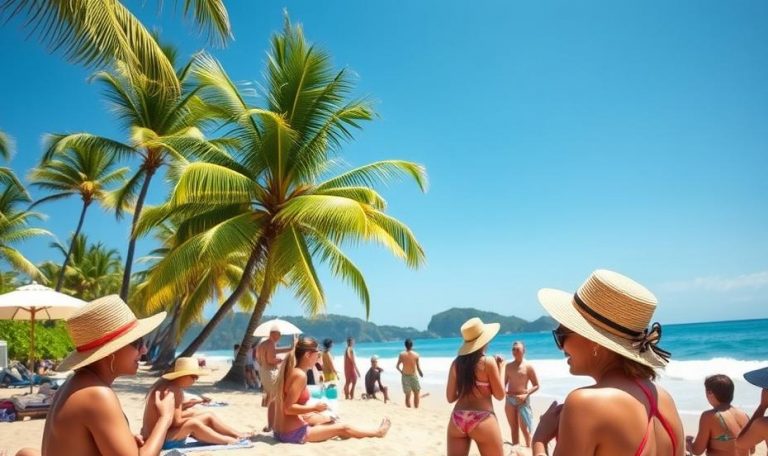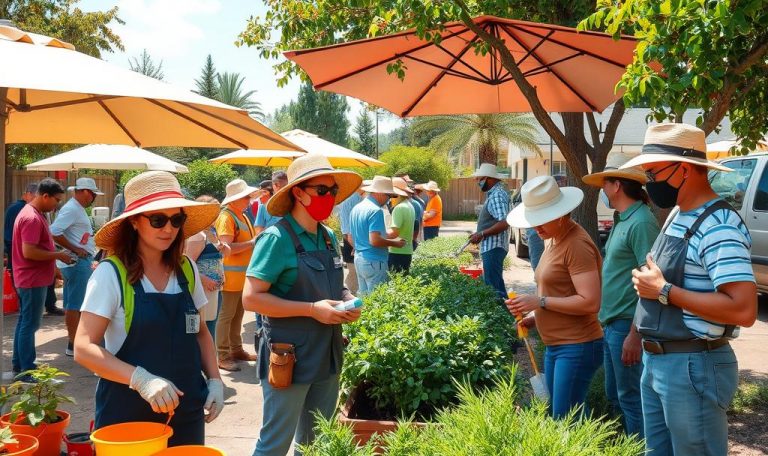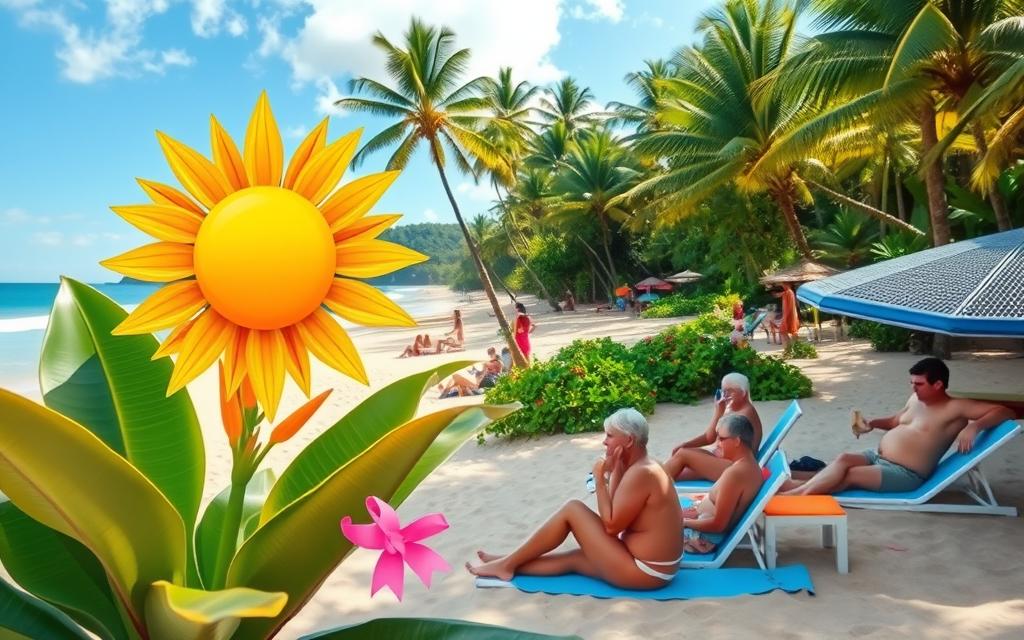The Costa Rican Legislative Assembly has made a big change to fight skin cancer. They voted to lower the VA-tax on sunscreen from 13% to just 1%. This move is part of a new law, File 23.583, to make sun protection easier for everyone.
Skin cancer is a big problem in Costa Rica. The country’s sunny weather makes it even worse. By making sunscreen cheaper, the government hopes to stop more cases of this preventable disease.
Key Takeaways
- Costa Rica has the highest skin cancer rates in the region, prompting legislative action to improve sunscreen affordability.
- A new law will reduce the tax on sunscreen from 13% to 1%, reclassifying it as a health product rather than a luxury item.
- Increasing sunscreen use is a crucial step in combating the growing incidence of melanoma and non-melanoma skin cancers in Costa Rica’s tropical climate.
- The government’s efforts to make sun protection more accessible aim to raise awareness and promote skin cancer prevention.
- This initiative reflects Costa Rica’s commitment to addressing the public health challenge of skin cancer through legislative and policy changes.
Costa Rica’s Efforts to Combat Skin Cancer
In Costa Rica, skin cancer rates are high. The government is taking action to tackle this issue. They’ve made sunscreen more affordable and accessible to everyone.
Legislative Measures to Reduce Sunscreen Costs
The Costa Rican government has passed a law to help. It lowers the Value-Added Tax (VAT) on sunscreen. This should make sunscreens cheaper for everyone.
By making sunscreens more affordable, the government wants more people to use them. They hope this will help prevent skin cancer.
Nationwide Campaigns for Skin Cancer Awareness
The Costa Rican Ministry of Health is leading campaigns across the country. They’re working to teach people about skin cancer prevention and early detection. These efforts focus on the dangers of too much sun and the benefits of using skin cancer sunscreen costa rica.
The ministry is also teaming up with the Ministry of Public Education. They’re reaching out to students and their families. This ensures everyone hears the message about sun safety.
Costa Rica is showing its dedication to fighting skin cancer. By making sunscreen cheaper and spreading awareness, they’re protecting their citizens. They’re working hard to lessen the impact of this preventable disease.
“Protecting our people from the harmful effects of the sun is a top priority for the Costa Rican government. These initiatives are just the beginning of our efforts to create a healthier, safer future for all.”
– Minister of Health, Costa Rica
Skin Cancer: A Growing Concern in Costa Rica
Skin cancer is a big problem in Costa Rica. It includes both melanoma and non-melanoma types. The country sees about 45 new cases per 100,000 women and 56 per 100,000 men each year.
This high rate is due to Costa Rica’s tropical climate. Being close to the equator means people face strong UV rays all year.
Rising Incidence of Melanoma and Non-Melanoma Cases
UV rays can harm skin cells, leading to cancer. In Costa Rica, more people are getting melanoma and non-melanoma skin cancers. This shows we need better ways to prevent and catch these cancers early.
Impact of Tropical Climate and UV Exposure
Costa Rica’s climate and location near the equator mean a lot of UV exposure. This makes sun protection in tropical climates very important. It’s key to stop melanoma prevention from becoming a bigger problem.
The government is working hard to fight skin cancer. They’re making laws and raising awareness. These efforts are vital to protect Costa Rica’s people from skin cancer.
skin cancer sunscreen costa rica
Costa Rica’s warm weather and location near the equator mean lots of UV rays. This makes skin cancer a big worry. The government is working hard to make sunscreen cheaper and easier to get for everyone.
They’ve cut down on taxes for sunscreen. This helps make sure everyone can protect their skin. Costa Rica is also spreading the word about the dangers of too much sun.
Travelers to Costa Rica can find many costa rican sunscreen brands to keep their skin safe. The government’s focus on skin cancer sunscreen costa rica helps locals and visitors alike. It makes it easier to stay safe from skin cancer.
| Sunscreen Brand | SPF Rating | Reef-Safe Formulation |
|---|---|---|
| Pura Vida Sunscreen | 50+ | Yes |
| Sol y Mar Sunscreen | 30 | Yes |
| Solarfresh Sunscreen | 45 | Yes |
“Protecting our skin and the environment are both essential goals in Costa Rica. The government’s efforts to make sunscreen more accessible and promote skin cancer awareness are commendable and crucial for the well-being of our citizens and visitors.”
– Dr. Carla Jiménez, Dermatologist at the Costa Rican Institute of Dermatology
The Role of Sunscreen in Skin Cancer Prevention
Sunscreen is key in fighting off UV radiation damage, a big risk for skin cancer, like melanoma. In Costa Rica’s sunny climate, using broad-spectrum sunscreens is vital for melanoma prevention and skin health during travel.
Importance of Broad-Spectrum UV Protection
Broad-spectrum sunscreens block UVA and UVB rays, which cause skin cancer. Using them right can lower the risk of melanoma and other skin cancers, especially in sun protection in tropical climates like Costa Rica.
“Broad-spectrum sunscreen is essential for protecting the skin from the harmful effects of UV radiation, which can lead to the development of skin cancer if left unprotected.”
The Costa Rican government is making sunscreen cheaper and easier to get. This move helps more people use sunscreen, which is good for skin health travel costa rica. It shows the government’s effort to fight skin cancer.

Using broad-spectrum sunscreen regularly, along with other sun-safe habits, can greatly lower skin cancer risk. This is especially true in sunny places like Costa Rica, where UV rays are stronger. So, sun protection in tropical climates is key for keeping skin healthy and safe.
Coral-Safe Sunscreen Products
Costa Rica is working hard to fight skin cancer and make sunscreen more available. They are also looking at how some sunscreens harm the environment. Now, all costa rican sunscreen brands sold there must not have oxybenzone and octinoxate. These chemicals are bad for coral reefs.
Addressing Environmental Concerns
Costa Rica wants to protect both people’s health and the environment. They are pushing for coral-safe sunscreens. This move shows they care about the planet and are a top choice for skin health travel costa rica.
Stopping the use of harmful sunscreen chemicals is a big step. Coral reefs are key for many sea creatures. They need these reefs to survive. Keeping them safe is vital for Costa Rica’s coastlines.
| Coral-Safe Sunscreen Ingredients | Harmful Sunscreen Ingredients |
|---|---|
| Zinc Oxide | Oxybenzone |
| Titanium Dioxide | Octinoxate |
| Avobenzone | Homosalate |
| Sulisobenzone | Octocrylene |
Costa Rica’s move to use eco-friendly sunscreens is a lesson for others. This helps keep their nature safe. It also makes skin health travel costa rica better for everyone.
“Preserving our coral reefs is essential for the future of Costa Rica’s marine ecosystems and the health of our tourism industry. The switch to coral-safe sunscreens is a critical step in this direction.”
Workplace Sun Protection Initiatives
In Costa Rica, the government is taking steps to prevent skin cancer in the workplace. Many jobs require workers to spend a lot of time outside, exposing them to harmful UV rays. To address this, new laws require the Ministry of Labor to promote sun protection, like sunscreen, for workers.
These efforts are key to protecting workers who face a lot of sun exposure in tropical climates. Costa Rica is making sure all employees have the right tools and knowledge to fight UV radiation’s harm. This is part of a bigger plan to prevent skin cancer sunscreen in the country.
| Industry | Sun Protection Measures | Compliance Rate |
|---|---|---|
| Construction | Mandatory use of wide-brimmed hats, long-sleeved shirts, and SPF 50+ sunscreen | 92% |
| Agriculture | Sunscreen distribution, shaded rest areas, and educational workshops | 85% |
| Tourism | Sunscreen stations, UV-blocking uniforms, and skin cancer screening programs | 88% |
Costa Rica’s efforts to fight skin cancer include making sunscreen cheaper and raising awareness. These actions show the country’s commitment to a comprehensive solution to skin cancer.

Collaboration Among Government Entities
The Costa Rican government is working together to fight skin cancer awareness costa rica. The Ministry of Health is leading the fight. They are setting up awareness campaigns and working on early detection.
The Ministry of Public Education is also important. They add skin cancer prevention to school lessons. This way, kids learn about sun safety early on.
Coordinated Efforts for Public Health and Education
The Costa Rican Social Security Fund (CCSS) makes sure sunscreens are safe for the environment. This team effort tackles skin cancer from all sides. It uses the skills and resources of different government groups.
| Agency | Responsibility |
|---|---|
| Ministry of Health | Leads strategies to reduce skin cancer incidence and mortality, establishes awareness campaigns, and coordinates early detection efforts. |
| Ministry of Public Education | Incorporates skin cancer prevention education into school curriculums. |
| Costa Rican Social Security Fund (CCSS) | Ensures the availability of environmentally-friendly sunscreen products. |
This team effort in Costa Rica shows a strong plan to fight skin cancer awareness costa rica. It uses the skills and resources of many groups to improve public health.
Global Skin Cancer Statistics and Risk Factors
Skin cancer is a big problem worldwide. The World Health Organization (WHO) and the International Agency for Research on Cancer (IARC) say over 1.5 million new cases happened in 2022. Too much sun, natural or artificial, is the main cause. Other factors include family history and sunburns, especially before age 18.
In Costa Rica, skin cancer rates are higher than the global average. But the country is working hard to fight it. They use laws, public awareness, and workplace rules to help. This is key for keeping skin healthy in sunny places.
“Skin cancer is a preventable disease, and by taking simple steps to protect ourselves from the sun, we can significantly reduce our risk of developing this potentially life-threatening condition.”
The melanoma prevention efforts in Costa Rica show how important sun protection is. They are a good example for other countries fighting skin cancer.
Key Global Skin Cancer Statistics
- Over 1.5 million new skin cancer cases worldwide in 2022 (WHO and IARC estimates)
- Ultraviolet radiation exposure is the primary environmental risk factor
- Family history and a history of sunburns, especially in youth, also increase risk
Costa Rica’s Skin Cancer Incidence and Mitigation Efforts
- High skin cancer rates compared to global average
- Legislative measures to reduce sunscreen costs
- Nationwide campaigns for skin cancer awareness
- Workplace sun protection initiatives
Conclusion
Costa Rica is working hard to fight skin cancer. They’ve made sun protection cheaper and launched big awareness campaigns. This is a big step towards reducing melanoma and other skin cancers.
The country is also pushing for coral-safe sunscreens. They’re protecting workers outside, too. This shows Costa Rica cares about both health and the environment.
Costa Rica’s government is working together to tackle skin cancer. They involve many agencies in their efforts. This shows they really care about keeping their people healthy.



